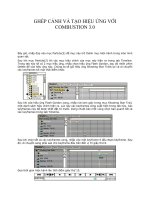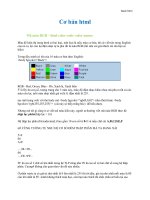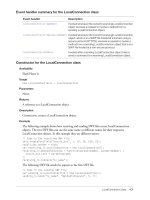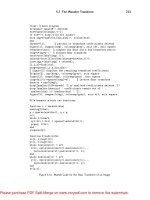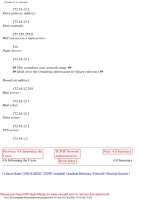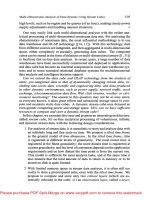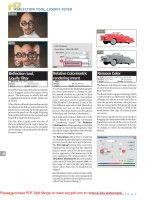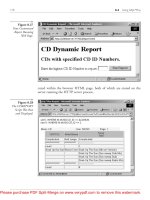FASHION DRAWING- P5 docx
Bạn đang xem bản rút gọn của tài liệu. Xem và tải ngay bản đầy đủ của tài liệu tại đây (4.27 MB, 30 trang )
1st Proof Title: (AVA): BFD: Fashion Drawing
Job No: D809-96 / 4255
SIF AVABF5 Chpt5 17.08 ED_120-147 8/27/09 11:26 AM Page 120
Text
Black
1st Proof Title: (AVA): BFD: Fashion Drawing
Job No: D809-96 / 4255
SIF AVABF5 Chpt5 17.08 ED_120-147 8/27/09 11:24 AM Page 120
1
120 / 121
1st Proof Title: (AVA): BFD: Fashion Drawing
Job No: D809-96 / 4255
SIF AVABF5 Chpt5 17.08 ED_120-147 8/27/09 11:26 AM Page 121
Text
Black
In this chapter the important differences and distinctions
that coexist between fashion presentation formats are
considered. Building on an understanding of the fashion
figure and the role of technical drawings for fashion, this
chapter explores how they may be grouped together as
part of a coherent presentation. The particular perspective
of fashion illustration is considered in relation to other
artwork formats, while a range of artwork boards, sometimes
ambiguous in nature, are visually presented and explained.
We look at the growing influence of digital presentation
platforms, including websites and blogs. The chapter is
richly supplemented by interviews with three inspirational
illustrators who each apply their different styles and talents
to contemporary fashion illustration. Their distinctive media
choices and eclectic styles are testimony to the diverse
language used by fashion drawing today.
Presentation formats
1 Illustration by Luis Tinoco.
To create something exceptional, your mindset must
be relentlessly focused on the smallest detail.’
Giorgio Armani
Colouring and rendering > Presentation formats > Fashion portfolios
‘
1st Proof Title: (AVA): BFD: Fashion Drawing
Job No: D809-96 / 4255
SIF AVABF5 Chpt5 17.08 ED_120-147 8/27/09 11:24 AM Page 121
1 2
2nd Proof Title: (AVA): BFD: Fashion Drawing
Job No: CD909-142 / 4228
SIF AVABF5 Chpt5 17.08 ED_120-147.qxp 9/19/09 10:35 AM Page 122
Presentation formats
Presentation formats
1–3 Fashion illustrations by
Timothy Lee (1) and Tahsin
Osman (2–3).
Fashion illustration
Fashion illustration describes a particular approach to fashion
drawing that exemplifies artistic expression and stylisation of the
human form. On the whole it is concerned not so much with
an accurate representation of the garment or outfit, but with
communicating the allure or attitude of the design. In this regard
fashion illustration may be considered as being distinct from fashion
sketching. We may also refer to fashion illustrators as distinct from
fashion designers, although both work in complementary ways and
the production of fashion artwork is common to both practices.
Some of the most successful fashion illustrators have had little or
no design training and therefore do not involve themselves in the
complexities of pattern cutting or the manufacture of a garment. This
is not their function and it does not restrict an illustrator; they have
no need to add every seam, dart and tuck to their final illustrations.
In fact, such detailed information can sometimes make a fashion
illustration appear static or overworked, especially if the details
are already clarified in a designer’s flat drawing.
Fashion illustration is about capturing the mood, the spirit and the
essence of a design. Some of the most effective fashion illustrations
can appear almost effortless, inviting the viewer to imagine what lies
beneath the surface or to form personal interpretations. Of course,
illustrations are not effortless and developing an illustration is a
process in itself, one that requires practice, visualisation and
experimentation. Personal illustration styles evolve over time.
Text
Black
2nd Proof Title: (AVA): BFD: Fashion Drawing
Job No: CD909-142 / 4228
SIF AVABF5 Chpt5 17.08 ED_120-147.qxp 9/19/09 10:35 AM Page 122
122 / 123
3
1st Proof Title: (AVA): BFD: Fashion Drawing
Job No: D809-96 / 4255
SIF AVABF5 Chpt5 17.08 ED_120-147 8/27/09 11:26 AM Page 123
Fashion illustration > Presentation boards
Text
Black
1st Proof Title: (AVA): BFD: Fashion Drawing
Job No: D809-96 / 4255
SIF AVABF5 Chpt5 17.08 ED_120-147 8/27/09 11:24 AM Page 123
1
1st Proof Title: (AVA): BFD: Fashion Drawing
Job No: D809-96 / 4255
SIF AVABF5 Chpt5 17.08 ED_120-147 8/27/09 11:26 AM Page 124
Presentation formats
Presentation formats
Composition and layout
Composition in fashion illustration
refers to the arrangement of the
visual elements within its defined
dimensions, and the relationship
between these elements. As there
is such variety in fashion illustration,
applying fixed rules to composition is
not really appropriate. However, there
are some underlying principles that
should be considered by fashion
students – these may also be
regarded as intuitive.
The relationship between the
elements can be classified by what
is referred to as the ‘positive image’
and the ‘negative space’. The
positive image refers directly to the
subject, usually the human figure in
a fashion illustration, while negative
space refers to the space around
and between the subjects. The
positive image and negative space
are equally important in determining
a visually engaging composition.
Text
Black
1st Proof Title: (AVA): BFD: Fashion Drawing
Job No: D809-96 / 4255
SIF AVABF5 Chpt5 17.08 ED_120-147 8/27/09 11:24 AM Page 124
124 / 125
1st Proof Title: (AVA): BFD: Fashion Drawing
Job No: D809-96 / 4255
SIF AVABF5 Chpt5 17.08 ED_120-147 8/27/09 11:26 AM Page 125
Fashion illustration > Presentation boards
The layout of a successful fashion
illustration has considered placement
in order to achieve the desired effect
or visual impact. This is usually
aimed at capturing the viewer’s
attention and directing their eye
over the illustration. Before the arrival
of digital media this was achieved
through a manual process of rough
draft planning and gradually layering
up the composed illustration. Today,
the ability to work with separate
layers for digital images has
facilitated the process and made
it much more versatile. Once
in digital form, illustrations may
be edited and formatted to fit a
particular presentation or printing
requirement. Whichever route you
take, whether it is hand-rendered or
digital, planning and composing your
illustration is always important and
you should consider the illustration’s
purpose – for presentation or
inclusion within a portfolio.
1 Fashion illustrations by
Anna Walker.
Text
Black
1st Proof Title: (AVA): BFD: Fashion Drawing
Job No: D809-96 / 4255
SIF AVABF5 Chpt5 17.08 ED_120-147 8/27/09 11:24 AM Page 125
1
1st Proof Title: (AVA): BFD: Fashion Drawing
Job No: D809-96 / 4255
SIF AVABF5 Chpt5 17.08 ED_120-147 8/27/09 11:26 AM Page 126
Presentation formats
Presentation formats
Presentation boards
Most fashion students will be familiar with the term presentation
boards as they are frequently used when working on projects and
preparing a portfolio. The term is also used in the fashion industry
to refer to a variety of boards that communicate and sell ideas or
designs for commercial objectives.
Presentation boards are primarily concerned with presenting
ideas and designs to a defined audience with an appropriate
level of clarity, visual flair and professionalism. They serve different
complementary functions and, when considered within a project
or specific presentation, they should be visually linked. This might
include, for example, working across a template and colour code
style and using the same board dimensions within a presentation.
Strong compositional skills, and the ability to clearly communicate
information, are a distinct advantage when preparing a presentation
board. Presentation boards that are executed with clarity also convey
a student or designer’s organisational skills (and this is important for
working in fashion). Presentation boards should not blur into each
other or repeat the same information as the viewer or audience will
quickly lose interest or become confused.
Text
Black
1st Proof Title: (AVA): BFD: Fashion Drawing
Job No: D809-96 / 4255
SIF AVABF5 Chpt5 17.08 ED_120-147 8/27/09 11:24 AM Page 126
126 / 127
2
2nd Proof Title: (AVA): BFD: Fashion Drawing
Job No: CD909-142 / 4228
SIF AVABF5 Chpt5 17.08 ED_120-147.qxp 9/24/09 7:31 PM Page 127
Fashion illustration > Presentation boards > Digital presentations
1 Illustration boards by
Chi Hu.
2 Illustration board (top),
design board (middle)
and flats presentation
board (bottom) by
Thomas Rothery.
Text
Black
2nd Proof Title: (AVA): BFD: Fashion Drawing
Job No: CD909-142 / 4228
SIF AVABF5 Chpt5 17.08 ED_120-147.qxp 9/24/09 7:31 PM Page 127
2
1
1st Proof Title: (AVA): BFD: Fashion Drawing
Job No: D809-96 / 4255
SIF AVABF5 Chpt5 17.08 ED_120-147 8/27/09 11:26 AM Page 128
Presentation formats
Presentation formats
Mood board
One of the most frequently used
boards, and one that most fashion
students are introduced to first, is a
mood board. As its name suggests,
the purpose of this board is to set
the mood or tone for the design
boards or project work that follows.
The process of preparing a mood
board also enables a designer to
collect visual information from a
variety of sources and to organise
their inspirations and ideas into a
composed visual display. These
boards can vary considerably from
intense photomontages or composite
collages to rather spare visual
compositions that convey an ethereal
quality. Some mood boards are
tactile, others may be digitally
formatted. Depending on the
guidance provided by tutors or
professors, either type may be
acceptable but it is still important
that the board is planned, arranged
and edited into a coherent visual
composition.
Text
Black
1st Proof Title: (AVA): BFD: Fashion Drawing
Job No: D809-96 / 4255
SIF AVABF5 Chpt5 17.08 ED_120-147 8/27/09 11:24 AM Page 128
128 / 129
3
4
1st Proof Title: (AVA): BFD: Fashion Drawing
Job No: D809-96 / 4255
SIF AVABF5 Chpt5 17.08 ED_120-147 8/27/09 10:33 PM Page 129
Fashion illustration > Presentation boards > Digital presentations
Concept board
Concept boards can take the place
of a mood board when a context is
set for a project or collection. A
concept board might also include
references to colour palettes with
accompanying inspiration or direction
images. Concept boards may be
used for industry-linked projects,
known as ‘live’ projects, to introduce
the design boards that will follow.
They sometimes combine the
purposes of both a mood board
and a colour board, with the
additional focus of a context, and
should be visually engaging and
well-composed.
Title board
This board can sometimes take the
place of a mood board if a context
is already set and the student wants
the focus of their work to be linked to
a collection title or theme. Typically,
more advanced fashion design
students will use a title board to
introduce their work in conjunction
with other boards such as colour
boards, development boards and
subsequent artwork or design
boards. Title boards can be used
to good effect for introducing a
project within a portfolio.
1–4 Flats board (1), mood or
concept board (2) and
illustration boards (3–4)
by Lucy Chiu.
Text
Black
1st Proof Title: (AVA): BFD: Fashion Drawing
Job No: D809-96 / 4255
SIF AVABF5 Chpt5 17.08 ED_120-147 8/27/09 11:24 AM Page 129
2
1
2nd Proof Title: (AVA): BFD: Fashion Drawing
Job No: CD909-142 / 4228
SIF AVABF5 Chpt5 17.08 ED_120-147.qxp 9/19/09 10:39 AM Page 130
Presentation formats
Presentation formats
1–4 Illustration boards (1 and 3),
flats board (2) and colour
board (4) by Lucy Chiu.
Flats board
Although some designers include
flats with their illustrations, it is often
appropriate to prepare a separate
presentation board for flats and
thematically link them to your other
boards. In some sections of the
fashion industry this is common
practice, such as for active
sportswear and product categories
of menswear. Presenting flats on
a separate board can enable a
designer to give more artistic
expression to an illustration without
competing with a flat as part of the
same composition. Increasingly,
presentation flats are being drawn
and coloured with the aid of digital
graphics software. If you pursue
this approach you should consider
how it will work alongside your
other boards.
Range plan board
Prepared by design teams in the
fashion industry to ‘break down’
a collection into its constituent
parts across product categories or
consignment deliveries, range plan
boards (or line sheets as they are
known in the US), are used to clarify
final collections for presentation
to sales teams and buyers. These
boards utilise presentation flats to
clearly show each product style
against exact fabric swatches.
They might include a style number,
season, price and delivery date.
Range plan boards may be less
familiar to students, who will usually
produce smaller line-up sheets
drawn on the figure.
Text
Black
2nd Proof Title: (AVA): BFD: Fashion Drawing
Job No: CD909-142 / 4228
SIF AVABF5 Chpt5 17.08 ED_120-147.qxp 9/19/09 10:39 AM Page 130
130 / 131
4
3
2nd Proof Title: (AVA): BFD: Fashion Drawing
Job No: CD909-142 / 4228
SIF AVABF5 Chpt5 17.08 ED_120-147.qxp 9/19/09 10:40 AM Page 131
Fashion illustration > Presentation boards > Digital presentations
Line-up sheet
Used by more advanced fashion
students, the purpose of line-up
sheets is to present and edit final
collections in a line-up format that
allows the outfits to be evaluated
for their overall look, including their
catwalk/runway appeal. The designs
are drawn on the figure and not as
flats, with attention to styling, fit and
proportion. It is important, therefore,
that they are drawn to a consistent
scale and that the poses are not
overly dramatic as the purpose of
the line-up sheet is to enable critical
evaluation of the capsule collection.
They may be included in a final
portfolio but should not detract from
or duplicate final illustration work.
Colour board
Although colour stories can be
conveyed as part of a mood board,
theme board or range plan, a
separate colour board is sometimes
useful. Colour boards are used in
industry to clarify exact colours
and combinations within a product
category or merchandise theme.
Colour inspiration is important for
students of fashion and fashion
knitwear, who often include them
within their portfolios and provide
additional fabric or yarn samples.
It is important, however, to consider
colour consistency when producing
a colour board as your artwork
should be colour matched and the
colours accurately represented in
your design boards.
Text
Black
2nd Proof Title: (AVA): BFD: Fashion Drawing
Job No: CD909-142 / 4228
SIF AVABF5 Chpt5 17.08 ED_120-147.qxp 9/19/09 10:40 AM Page 131
2
1
2nd Proof Title: (AVA): BFD: Fashion Drawing
Job No: CD909-142 / 4228
SIF AVABF5 Chpt5 17.08 ED_120-147.qxp 9/19/09 10:44 AM Page 132
Presentation formats
Presentation formats
Text
Black
2nd Proof Title: (AVA): BFD: Fashion Drawing
Job No: CD909-142 / 4228
SIF AVABF5 Chpt5 17.08 ED_120-147.qxp 9/19/09 10:43 AM Page 132
132 / 133
3
2nd Proof Title: (AVA): BFD: Fashion Drawing
Job No: CD909-142 / 4228
SIF AVABF5 Chpt5 17.08 ED_120-147.qxp 9/19/09 10:44 AM Page 133
Fashion illustration > Presentation boards > Digital presentations
Illustration board or design board
Fashion illustration boards are an
important part of any fashion student
or designer’s portfolio and are usually
among the last to be viewed in the
sequence of a portfolio presentation.
In one sense they may even be
considered to be the finale of a
designer’s presentation since they
serve a more artistic role than the
other boards and can add a wow
factor to a portfolio. Some designers
may include flats with their figurative
drawings, while others may adopt a
more illustrative format. Determining
the format for a fashion illustration is
important and should be planned.
This includes whether the illustration
will be arranged in landscape or
portrait format as well as whether
to draw more than one figure on the
board. Arranging multiple figures can
be visually enhancing but should be
considered in relation to individual
model poses, gender and target
market or occasion. For example,
illustration boards for bridal wear and
high evening wear should emphasise
the uniqueness of the design and the
occasion, so individual illustrations
are more appropriate. Fashion figures
can be cropped and framed on
illustration boards depending on
the desired effect. Composing your
illustration is important and, given
the variety of approaches to fashion
illustration today, you should play to
your strengths and emphasise what
you can do best.
Development board
Some tutors and college professors
ask their students to prepare a
development board, which visually
presents key stages of their
development in the studio. This
enables students to extract some of
their best sketchbook work and
combine it with photographic images
of toiles/muslins as evidence of their
work in progress. Development
boards are useful; they can link a
mood board to the artwork or final
design boards. Although there is no
rule on how formally they should be
presented, some students include
them in their final portfolios.
1–3 Concept board (1),
flats/development board (2)
and illustration/design board
(3) by Miranda Folett-Millard.
Text
Black
2nd Proof Title: (AVA): BFD: Fashion Drawing
Job No: CD909-142 / 4228
SIF AVABF5 Chpt5 17.08 ED_120-147.qxp 9/19/09 10:43 AM Page 133
1st Proof Title: (AVA): BFD: Fashion Drawing
Job No: D809-96 / 4255
SIF AVABF5 Chpt5 17.08 ED_120-147 8/27/09 11:26 AM Page 134
Presentation formats
Presentation formats
Digital presentations
It is interesting to note the increasing popularity of websites and
blogs in which fashion drawings and illustrations are shared and
displayed alongside fashion photography and other associated
fashion imagery. These digital formats have extended the reach of
fashion drawing and presentation styles to a global audience, as well
as assimilating them into a digital cultural mix that appears open and
receptive to the variety of fashion drawing styles that exist today.
Blogs are also being taken up by fashion students who are actively
using them to network and promote their work through online
forums and digital gallery spaces. These developments are
consistent with the advances in digital graphics software, meaning
that fashion drawings are increasingly being viewed through screen-
based platforms as well as through a range of print media formats.
The continuing influence of digital media for fashion drawings and
presentations is likely to remain strong in the foreseeable future.
Graphics software, scanners and digital cameras are becoming more
sophisticated and a growing number of successful illustrators and
designers are using digital media either exclusively or in combination
with hand-rendering techniques. If fashion is about creating an ideal
and capturing the current mood and spirit of its age, then the digital
presentation of fashion artworks will continue to exert a powerful
influence over popular culture.
Text
Black
1st Proof Title: (AVA): BFD: Fashion Drawing
Job No: D809-96 / 4255
SIF AVABF5 Chpt5 17.08 ED_120-147 8/27/09 11:25 AM Page 134
134 / 135
3
2
1
1st Proof Title: (AVA): BFD: Fashion Drawing
Job No: D809-96 / 4255
SIF AVABF5 Chpt5 17.08 ED_120-147 8/27/09 11:26 AM Page 135
Presentation boards > Digital presentations > Cecilia Carlstedt
1 Fashion designer and
illustrator Richard
Haines’s blog <www.
designermanwhatisawtoday.
blogspot.com>
2 The work of fashion
illustrator Danny Roberts
is frequently featured on
blogs and websites.
3 Fashion illustrator Gladys
Perint Palmer showcases
her work on her website
<www.gladysperintpalmer.
com>
Text
Black
1st Proof Title: (AVA): BFD: Fashion Drawing
Job No: D809-96 / 4255
SIF AVABF5 Chpt5 17.08 ED_120-147 8/27/09 11:25 AM Page 135
1
2nd Proof Title: (AVA): BFD: Fashion Drawing
Job No: CD909-142 / 4228
SIF AVABF5 Chpt5 17.08 ED_120-147.qxp 9/19/09 10:45 AM Page 136
Presentation formats
Presentation formats
Cecilia Carlstedt, fashion illustrator
Please describe your current job
I work as a freelance illustrator.
What artistic training
have you had?
I have always drawn since I was
a young girl, but I began my formal
studies in art at a school called
Södra Latins Gymnasium in
Stockholm. I continued with more
theoretical education, studying art
history for a year at Stockholm
University. In 1998 I was accepted
on to the Graphic Design Foundation
course at the London College of
Printing. This led to a BA in the same
subject specialising in experimental
image-making. The course also
offered a five-month exchange
programme at The Fashion Institute
of Technology in New York.
How would you describe your
fashion illustration style?
Experimental, eclectic and with
a love for contrasts.
What type of media do
you like to use?
I mix traditional media like pencil
and ink in combination with modern
techniques including Illustrator,
Photoshop and photography.
How important are computer
graphics in your work?
It has become increasingly
important over time. I still prefer
a handmade look, but I have to
admit to being quite reliant on the
computer in the process.
What advice do you have for a
student who wants to work as
a fashion illustrator?
Experiment a lot with different media
to create your personal style. Always
keep updated on what’s going on in
the field.
What makes a great
fashion illustration?
For me it’s when you can see
that the creator has captured the
essence of the piece in a unique,
confident way.
What or who inspires you?
When I see something that
triggers the nerve to create; that
could be anything really, an unusual
colour combination, an interesting
face, and so on.
Artists who inspire me are many,
but to name a few: Elizabeth Peyton,
Luc Tuymans, Aubrey Beardsley,
Hokusai and Gustav Klimt.
1–2 Illustrations by
Cecilia Carlstedt.
Text
Black
2nd Proof Title: (AVA): BFD: Fashion Drawing
Job No: CD909-142 / 4228
SIF AVABF5 Chpt5 17.08 ED_120-147.qxp 9/19/09 10:45 AM Page 136
136 / 137
2
1st Proof Title: (AVA): BFD: Fashion Drawing
Job No: D809-96 / 4255
SIF AVABF5 Chpt5 17.08 ED_120-147 8/27/09 11:26 AM Page 137
Digital presentations > Cecilia Carlstedt > Luis Tinoco
Text
Black
1st Proof Title: (AVA): BFD: Fashion Drawing
Job No: D809-96 / 4255
SIF AVABF5 Chpt5 17.08 ED_120-147 8/27/09 11:25 AM Page 137
1
1st Proof Title: (AVA): BFD: Fashion Drawing
Job No: D809-96 / 4255
SIF AVABF5 Chpt5 17.08 ED_120-147 8/27/09 10:37 PM Page 138
Presentation formats
Presentation formats
Cecilia Carlstedt, fashion illustrator
1–2 Illustrations by
Cecilia Carlstedt.
Text
Black
1st Proof Title: (AVA): BFD: Fashion Drawing
Job No: D809-96 / 4255
SIF AVABF5 Chpt5 17.08 ED_120-147 8/27/09 11:25 AM Page 138
138 / 139
2
1st Proof Title: (AVA): BFD: Fashion Drawing
Job No: D809-96 / 4255
SIF AVABF5 Chpt5 17.08 ED_120-147 8/27/09 10:36 PM Page 139
Digital presentations > Cecilia Carlstedt > Luis Tinoco
Text
Black
1st Proof Title: (AVA): BFD: Fashion Drawing
Job No: D809-96 / 4255
SIF AVABF5 Chpt5 17.08 ED_120-147 8/27/09 11:25 AM Page 139
1
1st Proof Title: (AVA): BFD: Fashion Drawing
Job No: D809-96 / 4255
SIF AVABF5 Chpt5 17.08 ED_120-147 8/27/09 11:26 AM Page 140
Presentation formats
Presentation formats
Please describe your
current job as an illustrator
I am currently working on different
media projects based in different
countries. I usually work with
fashion magazines, newspapers
and textbooks. Basically I try to get
as close as I can to each target
audience; not only do I adapt my
style to each one of them, but I
also preserve the same essence
according to my own style and
technique.
What artistic training
have you had?
Illustration has always been a
hobby for me. I remember loving to
draw when I was younger and ever
since I have been furthering my
interest in it. This was by learning
several techniques such as painting,
watercolouring, charcoal drawing
and so on. However, I believe that
my degree in graphic design perhaps
has helped me the most in the
creation of images, not only to
compose and colour them but also
to interpret and reflect them in
images, ideas or concepts.
How would you describe your
fashion illustration style?
I would not define it as just one
pure style. To my understanding,
fashion is in constant progress,
always changeable, and my work
acclimatises to it. The same
would apply to the designers –
transformation and evolution is
unstoppable. I would say that the
real challenge is to reproduce that
evolution on a piece of paper.
Luis Tinoco, fashion illustrator
1–2 Illustrations by Luis Tinoco
for Glamour Germany.
Text
Black
1st Proof Title: (AVA): BFD: Fashion Drawing
Job No: D809-96 / 4255
SIF AVABF5 Chpt5 17.08 ED_120-147 8/27/09 11:25 AM Page 140
140 / 141
2
1st Proof Title: (AVA): BFD: Fashion Drawing
Job No: D809-96 / 4255
SIF AVABF5 Chpt5 17.08 ED_120-147 8/27/09 11:26 AM Page 141
Cecilia Carlstedt > Luis Tinoco > Sandra Suy
Text
Black
1st Proof Title: (AVA): BFD: Fashion Drawing
Job No: D809-96 / 4255
SIF AVABF5 Chpt5 17.08 ED_120-147 8/27/09 11:25 AM Page 141
1
2nd Proof Title: (AVA): BFD: Fashion Drawing
Job No: CD909-142 / 4228
SIF AVABF5 Chpt5 17.08 ED_120-147.qxp 9/19/09 10:46 AM Page 142
Presentation formats
Presentation formats
Luis Tinoco, fashion illustrator
What type of media do
you like to use?
I like using any possible method
when illustrating. To achieve that, I
explore new ways of expression. The
mixture (or collage) of different plastic
techniques is my main instrument.
The results are more rewarding and
innovative if I show certain versatility.
How important are computer
graphics in your work?
I use the computer together with
other methods. I do use it but not
primarily. In order to get hold of
realistic results and postures with
personality and individuality the use
of drawing is needed.
What advice do you have for a
student who wants to work as
a fashion illustrator?
Try to find a unique style that you
feel comfortable with and stick to it.
It will become your trademark and it
is what will make you different from
the rest. Also try to build a type of
work that would suggest your
personality and your life’s vision.
What makes a great
fashion illustration?
Elegance and strength are two
essential elements that need to
be considered when working
on fashion-related illustrations.
Moreover, they are key to making
someone stop, pay attention to it
and hopefully, keep it in the mind.
At the end of the day, it is all about
the transmission of feelings beyond
what is merely visual.
Who or what inspires you?
I always try to be aware of absolutely
everything that takes place around
me. Anything could be an inspiration
to me: people I see in the street,
music, TV, photo sessions
I also love to pay attention to artists
who have lived in a different period.
I think that if we still remember them
it must be because they have done
something good with their lives and
the job they did. Perhaps this is why
my illustrations have been defined
sometimes as being a bit ‘retro’,
which is a real compliment to me.
Text
Black
2nd Proof Title: (AVA): BFD: Fashion Drawing
Job No: CD909-142 / 4228
SIF AVABF5 Chpt5 17.08 ED_120-147.qxp 9/19/09 10:46 AM Page 142
142 / 143
2
SIF AVABF5 Chpt5 17.08 ED_120-147.qxp 9/22/09 8:59 AM Page 143
Cecilia Carlstedt > Luis Tinoco > Sandra Suy
1–2 Illustrations by Luis Tinoco
for Glamour Spain.
Text
Black
2nd Proof Title: (AVA): BFD: Fashion Drawing
Job No: CD909-142 / 4228
1
2nd Proof Title: (AVA): BFD: Fashion Drawing
Job No: CD909-142 / 4228
SIF AVABF5 Chpt5 17.08 ED_120-147.qxp 9/19/09 10:47 AM Page 144
Presentation formats
Presentation formats
Sandra Suy, fashion illustrator
Please describe your
current job as an illustrator
I work with different types of clients,
basically related to fashion, and
usually with very tight deadlines
so I have to work quickly.
What artistic training
have you had?
I studied art and fashion design for
five years. The rest of my training
has been on my own.
How would you describe your
fashion illustration style?
It’s influenced by classic fashion
illustration and I like thinking it’s
elegant and reflects beauty in a
good way.
What type of media do
you like to use?
In the beginning I used all kind of
artistic media, but now I’ve achieved
the same effects with my computer,
and it’s more comfortable.
1–2 Illustrations by Sandra Suy.
Text
Black
2nd Proof Title: (AVA): BFD: Fashion Drawing
Job No: CD909-142 / 4228
SIF AVABF5 Chpt5 17.08 ED_120-147.qxp 9/19/09 10:48 AM Page 144
